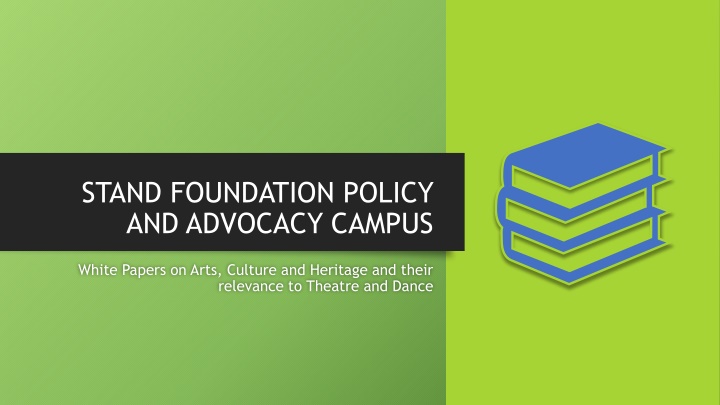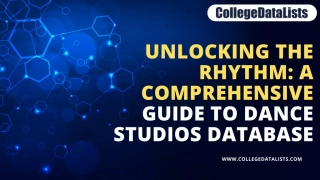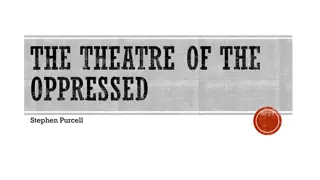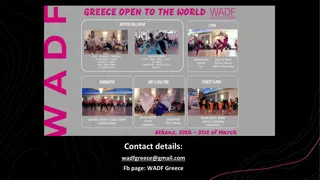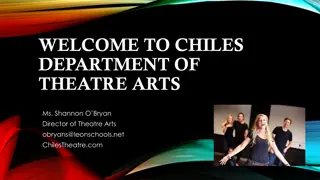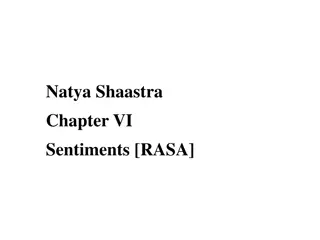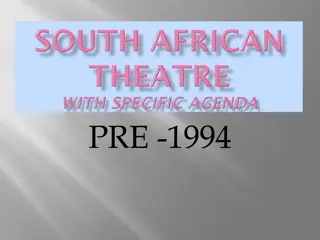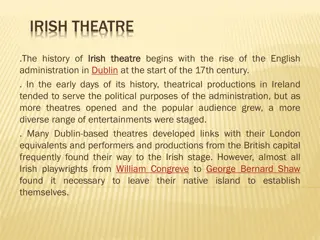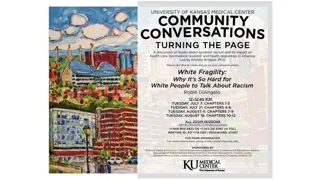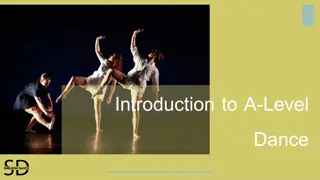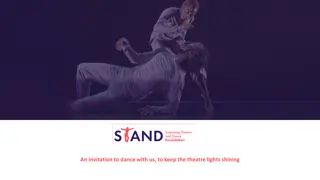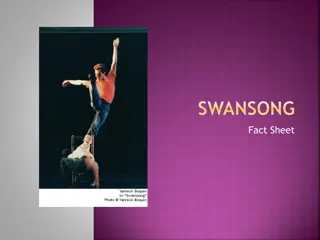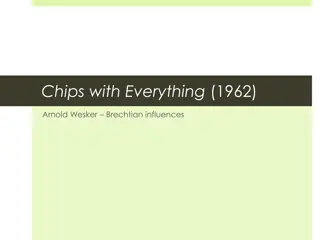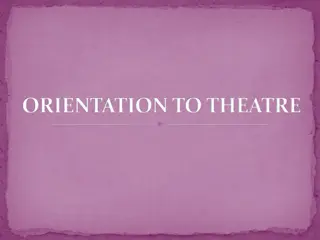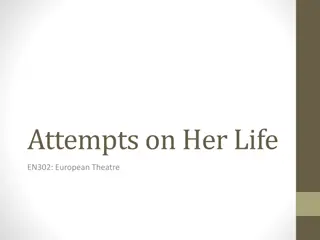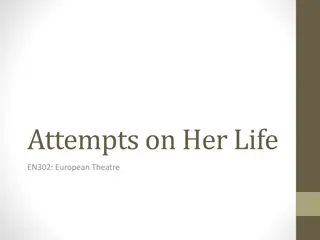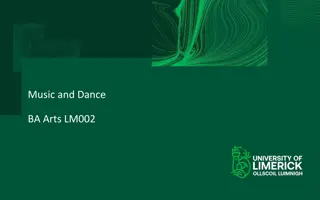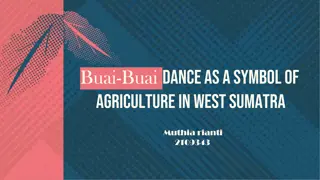Arts, Culture, and Heritage in Theatre and Dance: a Look at the 1996 White Paper
Delve into the background and significance of the 1996 White Paper on Arts, Culture, and Heritage as it pertains to Theatre and Dance. Discover the historical context, the process that led to its creation, and the specific content related to Theatre and Dance. Gain insights into the relevance and impact of this foundational document in the arts sector.
Download Presentation

Please find below an Image/Link to download the presentation.
The content on the website is provided AS IS for your information and personal use only. It may not be sold, licensed, or shared on other websites without obtaining consent from the author.If you encounter any issues during the download, it is possible that the publisher has removed the file from their server.
You are allowed to download the files provided on this website for personal or commercial use, subject to the condition that they are used lawfully. All files are the property of their respective owners.
The content on the website is provided AS IS for your information and personal use only. It may not be sold, licensed, or shared on other websites without obtaining consent from the author.
E N D
Presentation Transcript
STAND FOUNDATION POLICY AND ADVOCACY CAMPUS White Papers on Arts, Culture and Heritage and their relevance to Theatre and Dance
Context for 1996 White Paper History of process leading to the 1996 White Paper Theatre and Dance content of 1996 White Paper Context for Revised White Paper History and process leading to the 2017 Revised White Paper Status of Revised White Paper Theatre and Dance content of 2017 White Paper Reflections Conclusion Introduction
Context for 1996 White Paper Post-apartheid political dispensation Government of National Unity 9 provinces Performing Arts Councils Available finances Democratisation of the arts (infrastructure, funding, education, etc) Reconstruction and Development paradigm
History and Process State of Emergency (1985) and rise of arts organisations National Arts Initiative (1991) National Arts Policy Plenary (December 1992) National Arts Coalition (December 1993) Elections April (April 1994) Arts and Culture Task Group (November 1994 August 1995) White Paper (August 1996)
1. Crises leading to an organized sector State of Emergency, COVID-19 2. The importance of organisations created by the sector and the unity of the organisations (Chair of NAC, ACTAG, etc and policy proposals) 3. Political independence in order to advocate for the sector rather than align the sector to the ruling party s wishes. 4. Consultation and engagement between the Minister, DAC and Civil Society. 5. Necessity for arts organisations to do the research, thinking and proposals. Reflections
Content relevant to Theatre and Dance White Paper premised on Article 27 of the UDHR, Freedom Charter PACs restructured from production houses with inhouse companies to playhouses (infrastructure to be accessible) Declining national subsidies for 3 years; provincial and local government to play more active role National Arts Council established to democratize funding access Funds cut from PACs given to NAC to distribute (FCA incorporated) Community Arts Centres central to providing access and redressing imbalances Rights and status of artists: Labour, tax and social security laws to be evaluated against particular working conditions of artists
National Arts Council established, arms length funding principle Declining subsidies led to abolition of companies, except in WC State Theatre and PACOFS investments in pyramid scheme Market Theatre added to list of subsidized theatres Eastern Cape theatres of CAPAB fell off the subsidy list No devolution to local tiers Five theatres continue to consume primary theatre funding, little thought given to their appropriateness to post-1994 needs Community arts centres strategy not implemented effectively Reflection on implementation Artists remain in limbo with regard to taxation, labour laws, etc Principle of access, Article 27 of UDHR, Freedom Charter not upheld
Started under Minister, Paul Mashatile, 9 months before the 2014 election Post-2010 FIFA World Cup harness sport and culture to enhance social cohesion Context for Revision of White Paper (2013) Arts and culture (like other sectors) to meet the Triple Challenges Poverty: 50%+ of population lived below the poverty line Unemployment: 25,5% Inequality: 20% earned 70% of national income Emphasis then on the creative and cultural industries as drivers of economic growth, job creation and poverty alleviation
History and Process Process started by Paul Mashatile June 2013, Consultant to revise White Paper Arts indaba in late 2013 rejects rubberstamping New minister appointed after May 2014 election (Nathi Mthethwa) Process started afresh with consultations March 2015 4 November 2016 : Appointment of 9-member Reference Panel May/June 2016 provincial consultations Final draft due 31 July 2016, but only 3 members contributed, Aug 31 deadline Indaba 17-18 Nov, with 15 Dec 2016 for submissions Draft 1, 15 March 2015; Draft 2, 14 Nov 2016; Draft 3, 1 June 2017, Draft 4, 27 Oct 2017 published and finalized 20 July 2018
Status of Revised White Paper Cabinet adopted the Revised White Paper October 2018 Parliament endorsed the White Paper November 2019 Units within the DSAC now coming up with strategies, time frameworks for implementation
Reflection on process Length of time (June 2013-Nov 2019): 6,25 years (compared with Nov 1994-August 1996 process of first White Paper i.e. 1 year, 10 months) Absence of artists organisations in consultative and writing process, other than CCIFSA Creation, distribution and celebration of theatre and dance DESPITE policy rather than because of imagine if policies and funding were aligned with the talent/producing experience
National theatre and dance companies, in different provinces Audit of local theatres; three tiers of support Theatres for less-resourced provinces Subsidised theatres to generate 40% of their budgets Baxter theatre type institutions to be eligible for company and operational funding Biannual Performing Arts Market Subsidised theatres to employ a core group of dancers Dance tours to be funded Theatre and Dance Content of RWP
Artists rights to be given due consideration in taxation, definitions, social security, IP protection, Benevolent Fund Artists to have the right to form associations and have these publicly funded Affirmation of community arts centres and the building of a Federation of Community Arts Centres Give due emphasis to digital technology and its role/impact in the sector Miscellaneous
National Arts Council and National Film and Video Foundation to be amalgamated Catalyst Fund to provide seed funding Regional Fund to promote African cooperation Funding Investment Fund for private sector to invest in CCIs Accelerator Fund for professional mentorship, guidance Incubator Fund for professional development in safe spaces
Reflections Progressive policies regarding provincial infrastructure, funding of companies D j vu re artists rights, community arts centres, human resource development Goes to the DSAC: Not only about policy, also about driving and implementation - serious need to evaluate DSAC s leadership and capacity to drive and implement policy Amalgamation of councils of 5 subsidized theatres to be interrogated (not included in the Revised White Paper?) Adoption of White Paper in 2019, and little evidence of implementation
Organised arts sector should be be far more engaged in monitoring, advocacy for new policies, implementation and evaluation Civil society arts structures need to engage in more research, theorizing, thinking and preparation of documents outlining its interests Civil society to maintain a non-partisan approach and work across political lines in interests of the sector Focus should not only be on DSAC but other departments and more particularly on provincial and local governments www.dac.gov.za/white-papers Conclusion
